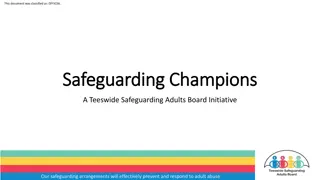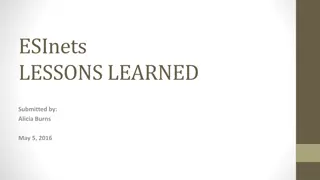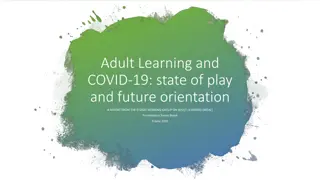Safeguarding Adult Reviews: Lessons Learned and Unlearned
Safeguarding Adult Reviews in England provide valuable insights into individual cases of abuse or neglect, with a focus on self-neglect. While there is a robust review mandate in England, other jurisdictions like Wales and Scotland emphasize broader protection of adults at risk. The review process lacks national oversight in England, raising questions about the effectiveness of safeguarding measures. Lessons learned from SARs can inform system changes and improve partnership working across different regions.
Download Presentation

Please find below an Image/Link to download the presentation.
The content on the website is provided AS IS for your information and personal use only. It may not be sold, licensed, or shared on other websites without obtaining consent from the author.If you encounter any issues during the download, it is possible that the publisher has removed the file from their server.
You are allowed to download the files provided on this website for personal or commercial use, subject to the condition that they are used lawfully. All files are the property of their respective owners.
The content on the website is provided AS IS for your information and personal use only. It may not be sold, licensed, or shared on other websites without obtaining consent from the author.
E N D
Presentation Transcript
Signposts out of England What are we learning and what have we not yet learned from the experience of safeguarding adult reviews?
My Aim Offer an analysis of the outcomes in England of section 44, Care Act 2014 Invite debate on how best to learn lessons and effect system change Reflect across to other jurisdictions
An evidence-base National SAR Analysis April 2017 March 2019 Learning from individual safeguarding adult reviews as an author and commissioner 98% response rate from SABs 29/132 had not completed any reviews Analysis of 246 reviews on self-neglect published (2020); number of reviews now over 330 231 SARs in the sample 45% focus on self-neglect Research on SARs, especially involving homelessness and alcohol-dependence Self-neglect the most frequent type of abuse or neglect reviewed
The Review Mandate In England, reviews require the presence of care and support needs (defined in the Care Act 2014) In Wales, Scotland and Northern Ireland, the focus is rather on adults at risk. In Wales, whether or not services have been provided to protect the person from abuse/neglect. SABs must arrange a SAR when: An adult with care and support needs dies as a result of abuse or neglect, whether known or suspected, and there is concern that partner agencies could have worked more effectively to protect the adult. Statutory mandate for reviews in Wales (Safeguarding Boards (Functions and Procedures) (Wales) Regulations 2015 but only implicit in APC functions (Adult Support and Protection (Scotland) Act 2007 with an interim framework only published in 2019. Does the Scottish position give APCs sufficient authority? An adult with care and support needs has experienced or is suspected of having experienced serious abuse or neglect and there is concern that partner agencies could have worked more effectively to protect the adult. Welsh Government Statutory Guidance and Scottish interim guidance similarly emphasise learning. SABs may arrange a SAR in any other situation involving an adult with needs for care and support where there is potential to identify valuable learning. Concise and extended reviews in Wales; initial case reviews and significant case reviews in Scotland. No such distinctions in England. SARs may cover all types of safeguarding cases, including modern slavery, self-neglect, domestic violence, institutional abuse, financial abuse, sexual and physical abuse. Is the focus on care and support needs too narrow (for example, not all people experiencing homelessness will have care and support needs)? SARs may explore good practice outcomes to improve partnership working. SAB decision-making may be challenged by way of judicial review in the High Court and investigated by the Local Government Social Care Ombudsman. Not all such outcomes exonerate SAB decision- making. Serious abuse where the adult survives is defined (statutory guidance 14.163) as where the person would have died but for an intervention and/or where the person suffered permanent harm or reduced quality of life. No National oversight in England of SAB decision-making.
Review Process Annual data in England on numbers of SARs commissioned but no data on types of abuse/neglect involved Welsh Government Statutory Guidance more prescriptive on timelines (how far back in time to focus) and use of genograms Welsh Government Statutory Guidance includes report templates, with a focus on succinctness (raises questions about structure of reports to generate learning about improvements to practice); Scottish interim guidance includes an exemplar report template Scottish interim guidance includes a person specification for reviewers Not all SABs comply with or meet the standards within the statutory guidance (National SAR Analysis, 2020), or accurately understand the statutory mandate in section 44 Care Act 2014. No regulatory framework in England to ensure compliance. Local Government Social Care Ombudsman investigations have sometimes found fault and injustice. Marked increase in 2019/20, with SARs on people who have survived abuse/neglect now greater than those on people who have died (NHS Digital Data)
SAB Governance: Compliance with Legal Rules? 1. Has decision- making distinguished mandatory and discretionary reviews? 3. What types of abuse and/or neglect are the main and secondary focus? 4. What methodology has been chosen and why? 2. How timely has decision- making on referrals been? 5. What methods for gathering/expl oring information have been chosen and why? 6. What positive/negati ve reasons for delay have impacted on the process? 8. What approach has been taken to subject and family involvement? 7. Have services and agencies cooperated as required? 9. Do annual reports provide required information: all SARs, findings and actions taken in response? 12. Have reasons for decisions at all stages of the process been recorded? 11. How has the SAB captured the outcomes of action taken? 10. How has SAR quality been assured?
Review Outcomes (1) No collation of data about reviews in Scotland (and Wales?) Are biennial reports submitted to the Scottish Government a vehicle for advocacy for change? National Safeguarding Board in Wales as a repository and conduit to government ministries, together having oversight of review findings If human stories (scandals) drive change, limited thematic analysis inhibits systemic change efforts No established mechanism (yet) in England for raising issues of national significance with Government Departments. No functioning national repository so no complete record of all SARs completed in England that can be searched (funding for set-up did not extend to maintenance and further development). No panel in England to review and respond to repetitive findings. Only data on number of SARs commissioned collected annually (and not by types of abuse).
Review Outcomes (2) No specified requirement for SABs to have a learning and development strategy. Little development work on capturing different types of outcomes. Schedule 2 requires annual reports to record all SARs commissioned and completed Statutory guidance does not require publication and balances this against consideration of confidentiality SAB websites difficult to navigate and reviews often removed after one year Questions therefore on accessibility and impact of lessons learned. Welsh Government Statutory Guidance requires multi-agency professional forums for practitioners and managers to learn from cases, audits, inspections and reviews to improve policy and practice. Scottish interim guidance advises a learning cycle based on a summary of reviewed cases
The 231 cases in the National SAR Analysis: demographics 263 subjects, 80% deceased 129 male, 109 female Average age 55 Little information about sexuality or ethnicity Range of health concerns and complex interplay Physical comorbidities Physical and mental ill-health + significant life events Living situations: Living alone (36%) Group care (33%) Location of abuse Own home (48%) Residential/nursing care (18%) Perpetrator Self (48%) Care providers (30%) Concluded prosecution = 16.2%
The 231 cases: types of abuse/neglect Type of abuse/neglect Reviews n % Modern slavery/sexual abuse/ sexual exploitation more prevalent in younger subjects Neglect/abuse by omission more prevalent in older subjects Psychological/emotional abuse and modern slavery more prevalent for females Financial, physical abuse and self-neglect are (slightly) more prevalent for males No correlation with types of abuse/neglect subject to s.42 enquiries Some types of abuse/neglect positively correlated with each other (e.g. domestic, financial, physical and emotional abuse); some appear unrelated to other types (self-neglect, neglect/omission) Self-neglect 104 45.02% Neglect/omission 85 36.80% Physical abuse 45 19.48% Organisational abuse 33 14.29% Financial abuse 30 12.99% Domestic abuse 22 9.52% Psychological abuse 19 8.23% Sexual abuse 12 5.19% Sexual exploitation 5 2.16% Modern slavery 2 0.87% Discriminatory abuse 2 0.87% Other 11 4.76% Not specified 29 12.55%
Good practice across the domains Health (56) Personalisation (53) Continuity (37) Care/support (36) Safeguarding (32) Mental capacity (32) Information- sharing (53) Case coordination (45) Safeguarding (37) Inter- agency Direct work SAB Organisation al governance Management oversight (10) Commissioning (6) SAR management (3) SAB policy/ procedures (2)
Poor practice across the domains Case coordination (168) Information-sharing (162) Safeguarding (115) Procedures (53) Legal literacy (44) Mental capacity (138) Risk assessment (134) Safeguarding (115) Caregivers (111) Care/support (110) Health (99) Direct work Inter- agency SAB Organisationa l governance Self-neglect policy (15) Escalation policy (14) Risk assessment policy (9) SAR management (9) Mental capacity policy (8) Staffing/workloads (64) Management oversight (63) Training (54) Resources (49) Commissioning (49)
Assessments absent or inadequate Failure to recognise and act on persistent and escalating risks Risk Mental capac ity Assessments missing, poorly performed or not reviewed Absence of detail about best interest decision-making Lack of focus on executive capacity Insufficient contact with the individual Unclear focus on individual s wishes, needs and desired outcomes Focus on autonomy excludes consideration of risks to others and duty of care MSP
Absence of attention to complex family dynamics; failure to involve carers Lack of curiosity about meaning of behaviour & key features in a biography Lack of time & agency encouragement of relationship & trust building; absence of continuity
Critique of team around the person provision Absence or non-use of multiagency forum Use of thresholds and eligibility criteria to gate-keep Inadequate recognition, referral and response to safeguarding Absence of escalation
Critique of organizational support for team members Missing or unclear policies; lack of attention to roll-out Insufficient attention to legal powers and duties Safeguarding knowledge and confidence Focus on case management and not reflective practice Failure to ensure staff competence for work required
Recommendations across the domains Case coordination (126) Information-sharing (96) Safeguarding (76) Procedures (54) Record-sharing (27) Risk assessment (72) Mental capacity (64) Caregivers (62) Care/support (56) Personalisation (47) Health (45) Direct work Inter- agency SAB Organisationa l governance Dissemination of learning (75) Quality assurance (50) Training (39) Self-neglect policy (34) Other [policy/procedures (33) Training (90) Commissioning (65) Quality assurance (48) Policy/procedures (42) Records/recording (38)
The national context SARs do not give sufficient attention to the legal, policy and financial context in which safeguarding practice takes place (c25% of SARs in the national analysis) Notable issues Impact of austerity Target bodies Department of Health & Social Care Ministry of Justice Department for Work & Pensions Home Office Crown Prosecution Service Care Quality Commission Legal rules Recognition of impact on victims Regulation of services Statutory guidance Coordination of parallel review systems National commissioning shortfalls NHS England Local Government Association Health & Safety Executive National Probation Service Prison Service Notable omissions Poverty Equality protected characteristics
A take on insufficiently systemic Less than 25% of SARs comment on the legal, policy and financial context in which adult safeguarding is situated. Why is there so little comment on: The working environment and its impact on staff, such as cultures, workloads, resources? The legal and policy context, and the extent to which mandates are helpful, weak, contradictory, unclear ..? Why is there so little focus on MCA 2005 and DPA 2018 when capacity and information- sharing are two recurring themes? Do SABs (not) consider it appropriate to direct recommendations to national bodies, including government? Very few recommendations about the legal, policy, financial and market contexts. Organisational structures partnership working grafted onto single agency structures, each organisation having its own financial challenges? Whether yet more procedures and/or training can actual ensure best practice when workplace development is crucial if practice is to be evidence-based and research-informed? To what degree is practice, and policy for practice, evidence-informed?
Sector-led improvement priorities SAB commissioning and conduct of SARs Support for sector-wide learning from SARs Support for adult safeguarding practice improvement Revisions to national policy / guidance Further research to develop the good practice evidence base
A corruption of care SARs and investigations Winterbourne View (2012) Institutional abuse Systemic issues A broken market Annual reviews insufficient Lack of oversight of placements Reliance on CQC reports Reliance on relatives reporting concerns Relationships between host and placing authorities Obscure business practices Inadequate regulatory requirements and a failure of enforcement Outdated models of care Abuse and neglect, bullying and cruelty Orchid View (2014) Ineffective leadership, management and regulation Operation Jasmine Mendip House (2017) Ineffective care planning and reviews Atlas Care Homes (2019) Failure by commissioners to share information Whorlton Hall Families kept at a distance Whistleblowing and complaints not followed through Lack of professional curiosity
Uncomfortable truths A corrupted world of service (Ash, 2010) high workloads, inadequate resources, ambiguous and conflicting agency policies, militating against alertness, attentiveness, responsiveness and challenge Service user characteristics lead to neutralisation of moral concerns (Wardhaugh and Wilding, 1993) reminiscent of categorisations of deserving and undeserving, in narratives of lifestyle choice Power and process in enclosed organisations (Wardhaugh and Wilding, 1993) islands and fortresses Conformity to organisational procedures leading to erosion of personal judgement (Adams and Balfour, 1998) Policy overload, time and workload pressures (Northway et al., 2007) Poverty of aspiration and ambition (Adult B, Brent SAB, 2018) reminiscent of poverty of provision and meanness of spirit (Bill Utting) Outdated models of care (Mendip House SAR, Somerset SAB) warehousing, reminiscent of critique of residential care in the 1980s (Rosemary Bland)
Why are we not getting to why? Do we not have an evidence-base of what good should look like, for example with respect to working with adults who self-neglect? Should a SAR not begin with the evidence-base and ask where are the enablers and where are the barriers to getting to good? Four domains of evidence Direct practice with the person Team around the person Organisations around the team SAB governance A fifth domain what are the national policy implications of these reviews?
Learning and Service Development Do Boards have a learning and development strategy? How and how often do Boards check implementation of recommendations and progress on action plans? How do Boards disseminate learning transfer from SARs into practice and management of practice? Training and procedural development, and learning transfer, can be effective but only if: Individuals are motivated to apply learning, believe they can effect change, and are supported to do so Practitioners and managers see the learning as relevant to the practice dilemmas and issues (such as workloads and resources) that they encounter There are clear learning goals which are followed up and evaluated, there are transfer as well as action plans, any training is relevant and based on individual and organisational needs Workplace is open to change and provides opportunities to apply new learning; workplaces are culturally and organisationally aligned to implement changes Peers, supervisors, managers support change, follow up and evaluate new practices Outcomes are evaluated in a constant cycle of improvement
Learning and service improvement strategy The purpose of a SARis to ensure there is a culture of continuous learning and improvement across the organisations that work together to safeguard and promote the wellbeing and empowerment of adults, identifying opportunities to draw on what works and promote good practice. Boards may be a guiding presence and process catalysts for change; they have responsibility but limited power; reliance on relationships (and budgets) Have Boards understood theories of change and what inputs are expected to produce what outputs and then outcomes? Where do Boards hope to see change?
Thinking about change a whole system conversation with SAB as the guiding presence What actions are necessary and by whom to achieve and sustain change How will we promote and evaluate change seminars, briefings, audits, reviews Where are we now and how might we reach where we need to be? What is the evidence base for what good looks like What are we trying to achieve?
Inputs to achieve the desired change Outcome s - benefits expected Aim - the change sought Outputs - expected products
Partner reactions Views of their experience of working with the SAB and in adult safeguarding Changing attitudes Perceptions of partnerships in adult safeguarding are modified Developing understanding and application in practice of procedures regarding assessment, intervention, purchaser/provider roles in adult safeguarding Knowledge and skill acquisition Changes in practice Implementing new learning about adult safeguarding by the workforce Changes in organisational behaviour Benefit to service users and carers Implementing new learning in organisational culture and procedures Improvements in wellbeing
What have SARs done for adult safeguarding? An evidence-base for best practice Brought order to dis-order but practice is messy, complex, often novel, full of emotion, contextual, relational, human Where is the passion, even scandal and outrage? These are, after all, human stories! Change is difficult to achieve, even for central government after Winterbourne View Partial solutions at the wrong systemic level a game without end When problems persist, move the focus to different levels or domains Neither a zoom-in close up nor a wide-angle zooming out Change in a system or changing the system?
References Preston-Shoot, M. (2018) Learning from safeguarding adult reviews on self- neglect: addressing the challenge of change. Journal of Adult Protection, 20(2), 78-92. Preston-Shoot, M. (2019) Self-Neglect and Safeguarding Adult Reviews: Towards a Model of Understanding Facilitators and Barriers to Best Practice. Journal of Adult Protection, 21 (4), 219-234. Preston-Shoot, M. (2020) Adult Safeguarding and Homelessness. A Briefing on Positive Practice. London: LGA and ADASS. Preston-Shoot, M. (2020) Making any difference? Conceptualising the impact of safeguarding adults boards. Journal of Adult Protection, 22 (1), 21-34. Preston-Shoot, M., Braye, S., Preston, O., Allen, K. and Spreadbury, K. (2020) National SAR Analysis April 2017 March 2019: Findings for Sector-Led Improvement. London: LGA/ADASS.
References (2) Ash, A. (2010) Ethics and the street-level bureaucrat: implementing policy to protect elders from abuse. Ethics and Social Welfare, 4 (2), 201-209. Adams, G. and Balfour, D. (1998) Unmasking Administrative Evil. London: Sage. Buckley, H. and O Nolan, C. (2014) Child death reviews: developing CLEAR recommendations. Child Abuse Review, 23(2), 89-103 Flynn, M. and Citarella, V. (2019) Connecting people s lives with strategic planning, commissioning and market shaping , in S. Braye and M. Preston-Shoot (eds) The Care Act 2014: Wellbeing in Practice. London: Learning Matters/Sage. Northway, R., Davies, R., Mansell, I. and Jenkins, R. (2007) Policies don t protect people, it s how they are implemented: policy and practice in protecting people with learning disabilities from abuse. Social Policy and Administration, 41, 1, 86-104. Wardhaugh, J. and Wilding, P. (1993) Towards an explanation of the corruption of care . Critical Social Policy, 37, 4-31.





















